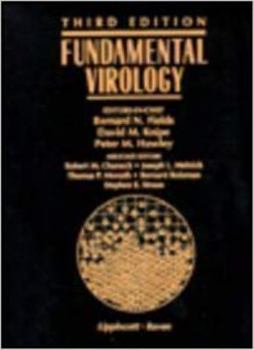Fundamental Virology
Select Format
Select Condition 
Book Overview
Represents the basic science chapters from FIELDS/VIROLOGY ...includes thoroughly updated chapters on virus taxonomy, pathogenesis of viral infections, & interferons. This description may be from another edition of this product.
Format:Hardcover
Language:English
ISBN:0781702844
ISBN13:9780781702843
Release Date:October 1995
Publisher:Lippincott Williams & Wilkins
Length:1360 Pages
Weight:7.45 lbs.
Customer Reviews
5 ratings
Superb
Published by Thriftbooks.com User , 20 years ago
For non-experts in the subject (such as this reviewer), this book gives a fascinating overview of organisms that have challenged humankind's domination of this planet. Although the book is targeted toward students and biologists, anyone who has a keen interest in virology will gain much from its perusal. Packed with diagrams, and containing hundreds of references, readers should have no problems in assimilating the information in the book, even though it is quite sizable. I only read chapters 1, 2, 5, 6, and 13 (due only to time constraints and not because the other chapters were deemed unimportant) so my review will be confined to listing some of the interesting facts and helpful features of the book. These include: 1. The discussion on the history of virology, especially the discussion on D'Herelle's dream and Koch's postulates. The early years of virology are impressive given that viruses could not be seen at the time due to the lack of suitable microscopes. 2. The actual number of species of viruses is 1550, with 2404 tentative species. 3. The methods by which the different viruses were identified experimentally, such as cell cultures and recombinant DNA technology. 4. The methods for measuring the infectivity of viruses. 5. The method of fluctuation analysis for measuring spontaneous mutation rates in viruses. The difference in spontaneous mutation rates between DNA and RNA viruses is astonishing. The authors point out the ability of RNA viruses to exist as "quasi-species", being capable of very rapid adaptation because of the high spontaneous mutation rate. 6. The simple replication abilities of RNA viruses, which although very error prone, results in very rapid evolutionary response. 7. In plant viruses, the existence of genome segments that are frequently packaged in distinct virions, which results in the need for several viruses to co-infect in order to transmit infectivity. 8. Viral RNA genomes are very rich and contain nearly every structural variation possible. 9. The role of horizontal gene transfer in producing the antigenic shifts that produce new pandemic strains of influenza. 10. The ability of cells to counteract virus infections by using gene silencing or the interferon system. Some viruses have evolved mechanisms for evading these defenses. 11. The replication strategies for DNA viruses, and the mechanisms that have evolved to evade host defenses. 12. Viral DNA replication is initiated by using proteins as primers. 13. The ability of viruses to evade host defenses by withdrawing into a latent state. Only a few proteins are expressed when the virus is in this latent state. The authors encourage the reader to pursue research into the mechanisms that are behind the initiation and release from latency, since at the time of writing these mechanisms are not well understood. 14. Gene therapy, certainly the most fascinating of all topics in virology and genetic engineering. 15. The role of self-inactivating (SIN) vectors in enhanc
the only book i will ever need
Published by Thriftbooks.com User , 23 years ago
As an undergraduate taking a course in virology, I found this book the only book I ever needed. It has all the information that you need and more. I just hope that they will continue to come out with a newer edition since this book is out of date and the field of virology has grown since this edition.
Need some basic science knowledge.
Published by Thriftbooks.com User , 25 years ago
I read the chapter on prions and i found it to be really good and up to date. of course it requires you to know a little background knowledge but if you're reading this book you probably already fill out that category. definitely not for the layman...
A must for anyone who needs virus reference information.
Published by Thriftbooks.com User , 26 years ago
Fields Fundamental Virology (and the more in-depth two volume Virology) provides an essential reference for anyone who works with viruses or needs to learn about them. It compiles the most up-to-date information and understanding written by experts. It is always my first (and usually only) stop in a search for information I need relating to viruses.
Indispensable
Published by Thriftbooks.com User , 27 years ago
This is not the most exciting book ever written about viruses, but it remains the classic reference work. If you want to find out about a particular virus, look here (or in the two volume Field's Virology) first. Each chapter is written by the absolute expert in the field. It is an indispensable resource for students, researchers, or anyone. It may not be sexy, but this is as good as it gets.





